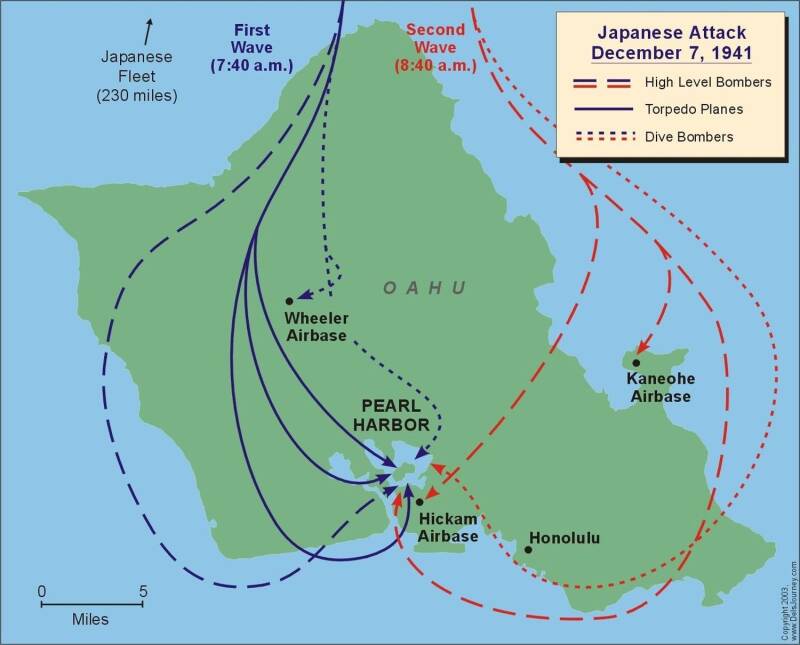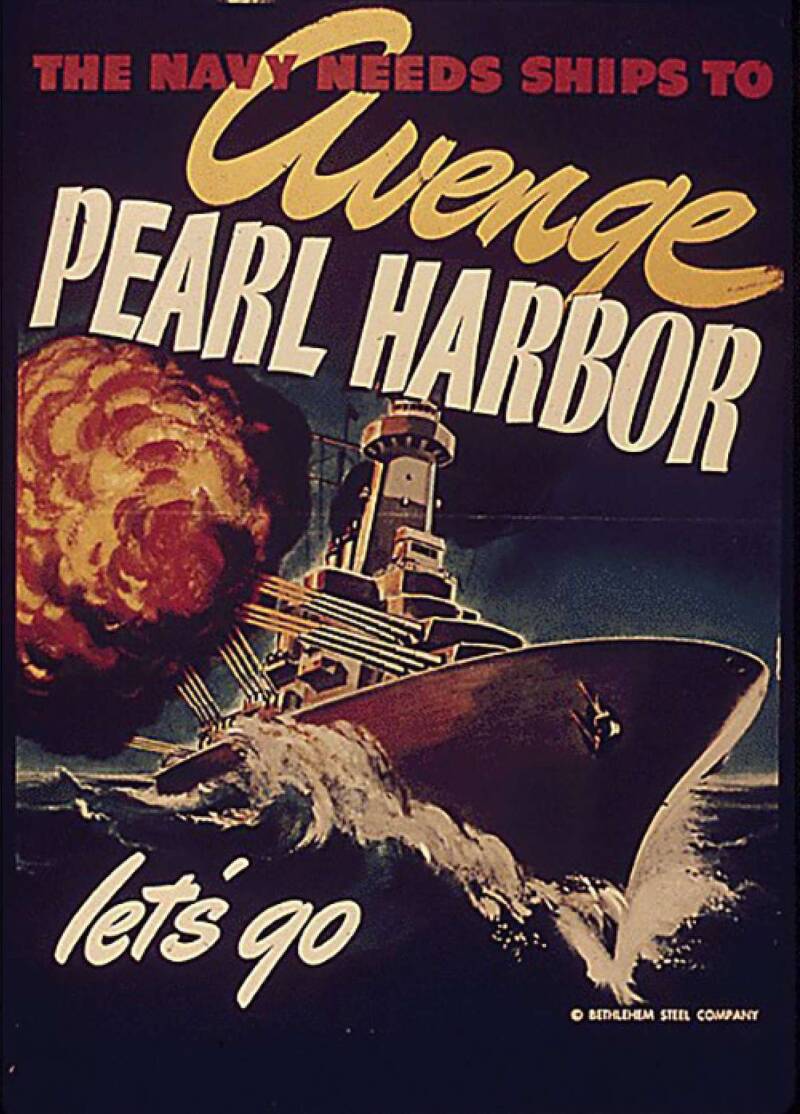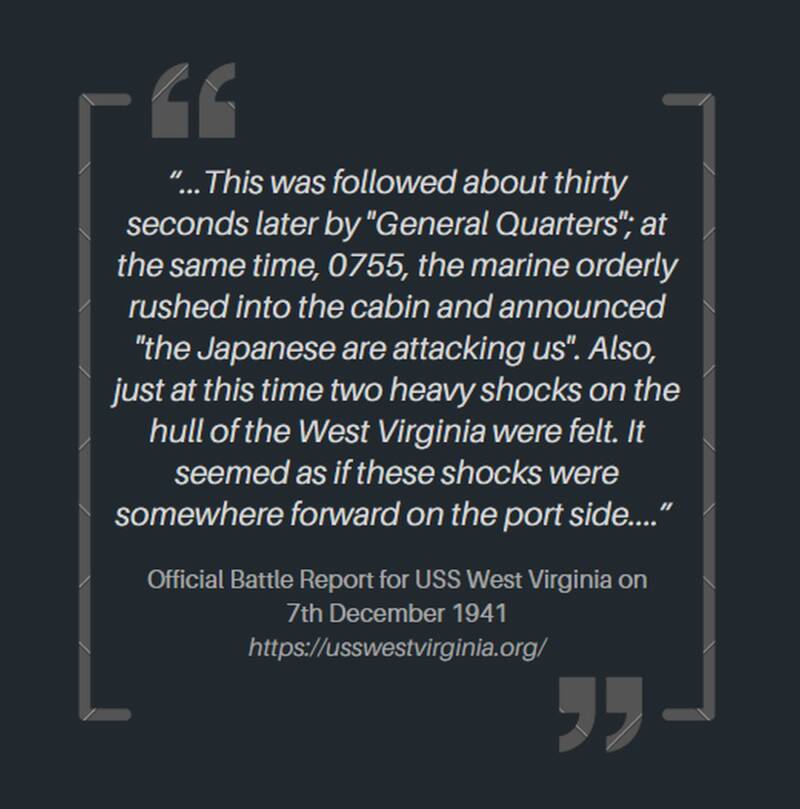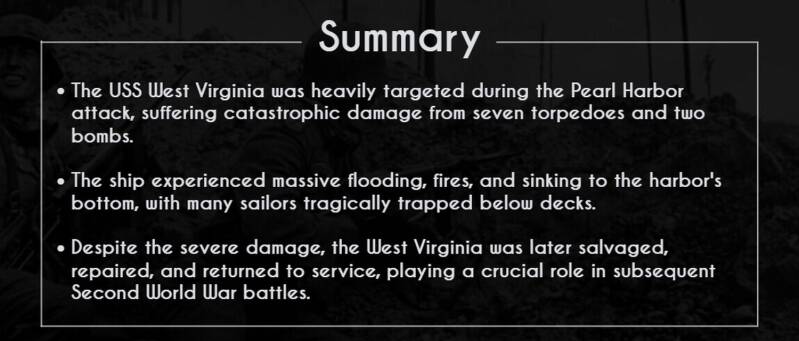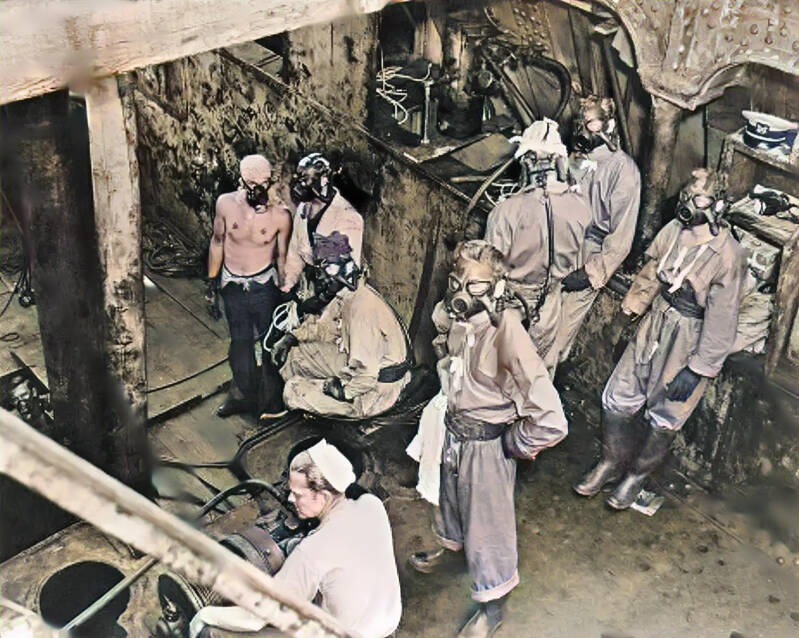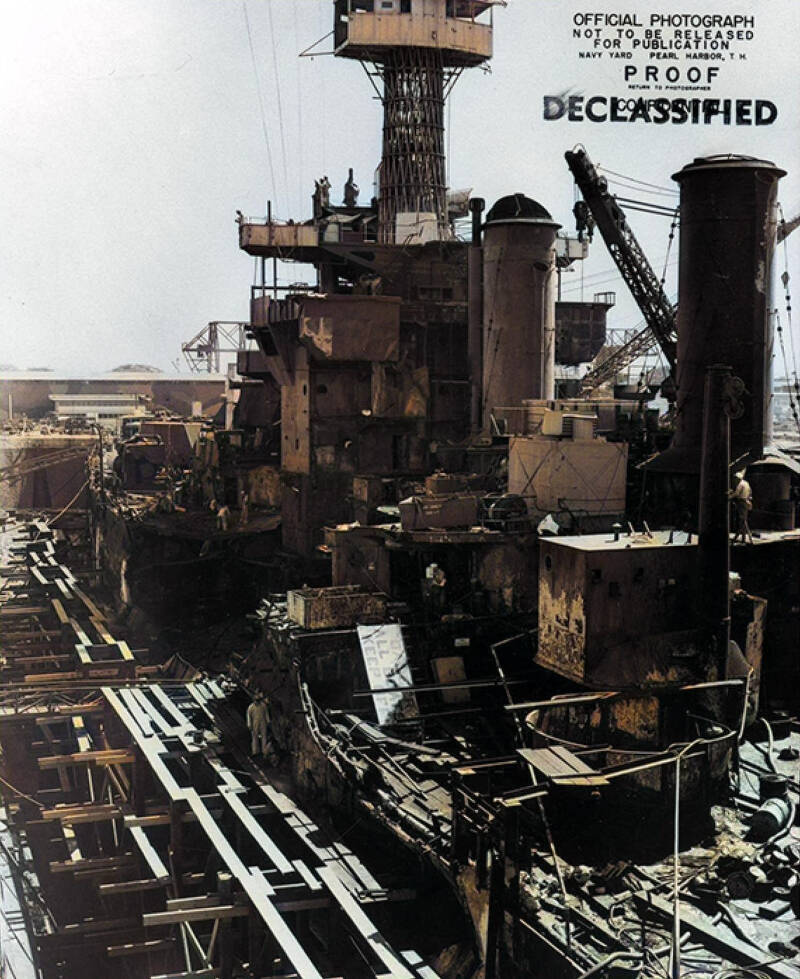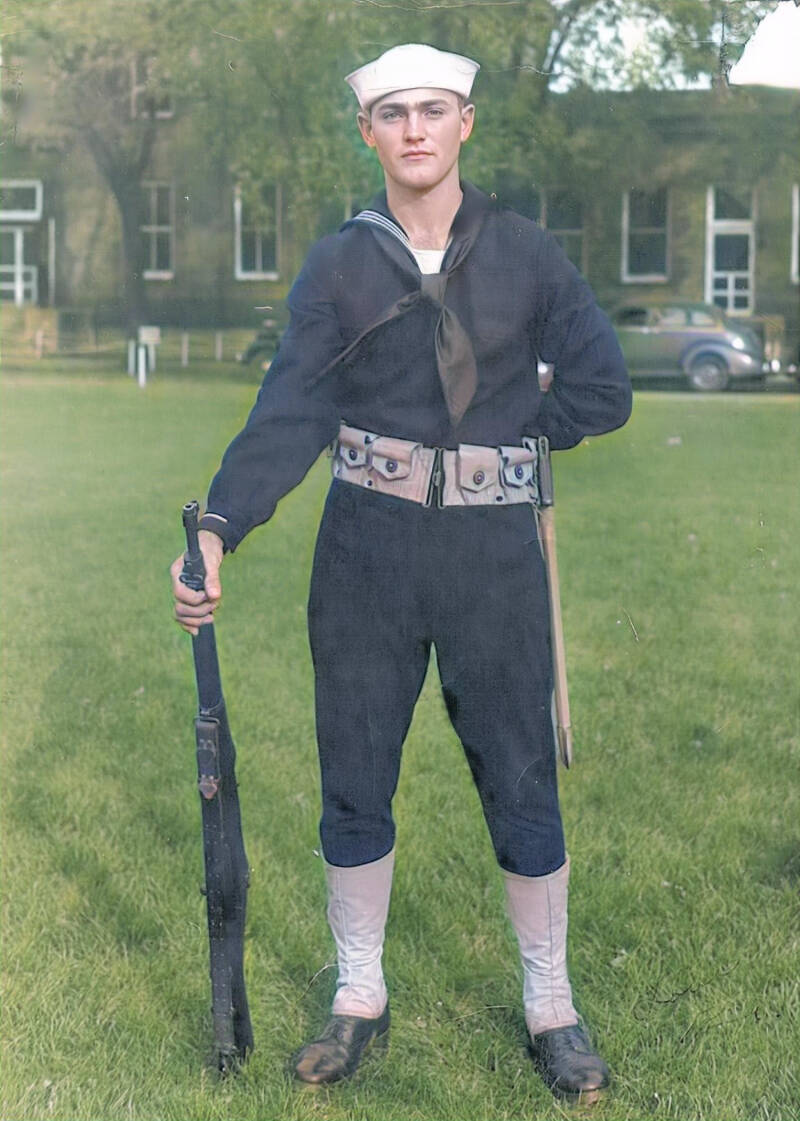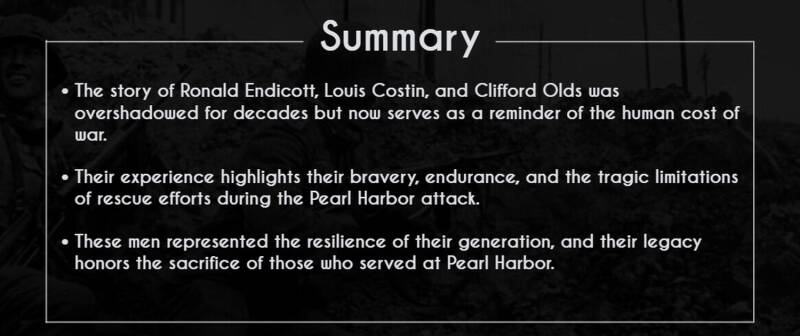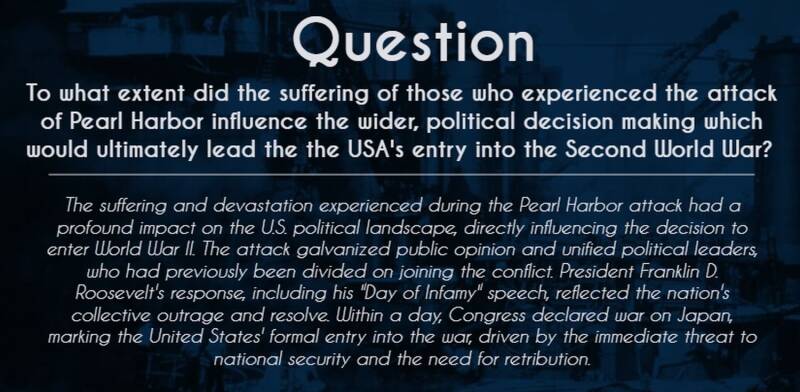Silent Sacrifice Beneath Pearl Harbor's Waves
Trapped sailors’ desperate fight for survival amid the wreckage of war
In the annals of the Second World War history, few events evoke as much profound sorrow and reflection as the attack on Pearl Harbor.
Among the countless stories of bravery and tragedy, one that stands out is the haunting tale of sailors trapped within the sunken battleships, most notably the USS West Virginia.
The harrowing details of their ordeal, which only emerged in the aftermath, reveal a poignant narrative of human endurance, despair, and the grim realities of war.
Ronald Endicott, Clifford Olds, and Louis Costin were young sailors aboard the USS West Virginia during the attack on Pearl Harbor. As the ship was heavily damaged and began to sink, the three men found themselves trapped deep within the battleship.
The aftermath of the Pearl Harbor attack: The surprise Japanese attack inflicted severe damage on the U.S. military, with eight battleships, three cruisers, and nearly 200 aircraft destroyed or damaged. Over 2,400 servicemen were killed, and key naval operations in the Pacific were temporarily crippled.
http://worldwartwo.filminspector.com/2019/03/color-photos-of-world-war-ii-part-16.html
Endicott joined the Naval Reserve at just 17, inspired by his desire to follow in his father's footsteps, who had served before him.
After 10 months of active duty, he found himself trapped in Pump Room A-109 aboard the USS West Virginia alongside Clifford Olds and Louis Costin when the Japanese attack struck the ship.
Despite the chaos and destruction around them, they relied on their resourcefulness and determination to survive for an extended period, isolated from the outside world and awaiting rescue in the heart of the wreckage.

Clifford Olds, 20 from Stanton, Mercer County, North Dakota

Ronald Endicott, 18, Skykomish, King County, Washington

Louis 'Buddy' Costin, 21, Henryville, Clark County, Indiana,
A Sudden Attack
The attack on Pearl Harbor, a pivotal moment in World War II, occurred on the morning of the 7th December 1941, when the Japanese Imperial Navy launched a surprise military strike against the United States.
This meticulously planned assault was intended to cripple the U.S. Pacific Fleet and secure Japan's dominance in the Pacific.
At 7:55 a.m., the first wave of Japanese aircraft descended on the unsuspecting American forces, unleashing a devastating barrage of bombs and torpedoes.
Within minutes, the serene atmosphere of the Hawaiian naval base was shattered, as explosions and gunfire echoed across the harbor.
The Japanese attack on Pearl Harbor, 7th December 1941. Before the Japanese attack, Oahu housed a significant portion of the U.S. Pacific Fleet at Pearl Harbor, including battleships, destroyers, and aircraft. Key military installations, such as Hickam Field and Schofield Barracks, supported the island's defense. However, American forces were largely unprepared for an imminent assault.
...more than 2,400 Americans lost their lives...
Pearl Harbor, a critical hub for the U.S. Navy, housed numerous battleships, cruisers, and aircraft. The attack, executed in two waves, targeted these vessels and the airfields surrounding the harbor.
The USS Arizona, one of the most iconic symbols of the attack, suffered a direct hit, causing a catastrophic explosion that resulted in the loss of 1,177 lives.
In total, eight battleships were damaged, with four—Arizona, Oklahoma, West Virginia, and California—sunk. Over 180 aircraft were destroyed, and more than 2,400 Americans lost their lives, with another 1,000 wounded.
Nakajima B5N2 attack bomber taking off from the Japanese Imperial Navy aircraft carrier 'Akagi', on the first attack wave on Pearl Harbor at approx 06.00hrs on Sunday 7 December 1941. The attack was carried out by six aircraft carriers (Akagi, Kaga, Soryu, Hiryu, Shokaku, and Zuikaku). 353 fighters, bombers and torpedo planes (the first wave of 183 dive bombers, torpedo bombers, level bombers and fighters)were launched in two waves from a task force of northwest of Hawaii.
...galvanized American resolve...
The impact of the attack on Pearl Harbor was immediate and profound.
The United States, which had been reluctant to enter the global conflict, was thrust into the Second World War as a direct result.
On the 8th December 1941, President Franklin D. Roosevelt delivered his famous "Day of Infamy" speech, declaring war on Japan.
The attack galvanized American resolve, uniting the nation in a determination to defeat the Axis powers.
Pearl Harbor remains a symbol of the unexpected nature of warfare, the cost of unpreparedness, and the resilience of a nation rising to face unprecedented challenges.
A US recruitment poster. The public reaction to the Pearl Harbor attack was one of shock, outrage, and grief. Americans united in resolve, fueling a surge of patriotism that led to widespread support for entering the Second World War.
https://www.nationalww2museum.org/war/articles/remembering-pearl-harbor
In just 90 minutes more than 2,400 Americans lost their lives and seventeen ships were damaged or lost. Of the sailors who perished, more than half were killed when the forward magazine of the USS Arizona exploded.
Royston Leonard / Mediadrumworld
https://www.dailymail.co.uk/news/article-5155311/Full-horror-Pearl-Harbor-brought-life-color.html
The USS West Virginia
The USS West Virginia, a formidable Colorado-class battleship, was moored at Pearl Harbor on the morning of the 7th December, 1941, when it became one of the primary targets of the Japanese surprise attack.
Positioned at the southernmost end of Battleship Row, the West Virginia bore the brunt of the assault, suffering extensive and catastrophic damage that nearly doomed the ship to a watery grave.
The battleship USS West Virginia is seen afire after the Japanese surprise attack on Pearl Harbor. The USS West Virginia sustained severe damage during the Pearl Harbor attack, struck by seven torpedoes and two bombs. The ship’s hull was breached, causing extensive flooding and fires, ultimately leading it to sink to the harbor floor.
...causing massive flooding...
In the first wave of the attack, the West Virginia was struck by an onslaught of seven torpedoes along its port side. These torpedoes tore through the ship's armor, causing massive flooding and rupturing vital compartments below deck.
Additionally, the battleship was hit by two armor-piercing bombs from dive bombers, one of which penetrated the deck and exploded deep within the ship, exacerbating the already critical situation.
Despite the crew's immediate and desperate efforts to counter-flood and stabilize the vessel, the West Virginia began to list heavily and eventually sank to the shallow harbor bottom, settling in the mud with only its superstructure remaining above water.
A small boat rescues a USS West Virginia crew member from the water after the Japanese bombing of Pearl Harbor, Hawaii on Dec. 7, 1941 during the Second World War. Two men can be seen on the superstructure, upper center. The mast of the USS Tennessee is beyond the burning West Virginia.
...many sailors were trapped below decks...
The damage to the West Virginia was devastating: the port side of the ship was heavily breached, and fires raged for hours due to ignited fuel and munitions.
The destruction was so severe that many sailors were trapped below decks, unable to escape the rising water and flames.
The battleship, once a symbol of American naval strength, was now a twisted, burning wreck. Despite this, the West Virginia was eventually salvaged, repaired, and returned to action, serving with distinction later in the war.
USS West Virginia BB-48 after reconstruction at Puget Sound July 2 1944. After the Pearl Harbor attack, the USS West Virginia underwent extensive salvage and repair efforts. Raised from the harbor floor, the battleship was towed to dry dock, where it was meticulously rebuilt and modernized. By 1944, the USS West Virginia returned to service, playing a crucial role in later Pacific battles.
Aftermath
In the immediate aftermath of the attack, the harbor was a scene of frantic activity. Rescue operations commenced as sailors and Marines scrambled to save those who could be reached. However, amidst the clamor and confusion, a series of peculiar noises began to echo through the water.
At first, these sounds were dismissed as the creaks and groans of damaged ships settling or the noise of debris shifting in the water.
But as the hours wore on, it became clear that these sounds were not merely the random clatter of wreckage but something far more deliberate and tragic.
Rescue and Salvage Efforts After Attack on Pearl Harbor. Salvage efforts after the Pearl Harbor attack were extensive and challenging. Crews worked for months to raise sunken ships, repair damaged vessels, and recover remains. The USS West Virginia and other battleships were eventually salvaged, repaired, and returned to service in the war.
Library of Congress - edited version © Science Faction/Getty Images
...a persistent, eerie banging...

The day following the attack, crew members stationed near the wreck of the USS West Virginia reported hearing a persistent, eerie banging coming from within the forward hull of the sunken ship.
This unsettling noise was soon recognized for what it was: the desperate signals of sailors trapped within the wreck, banging on the metal walls of their watery tomb in the hope that someone above might hear and come to their rescue
For those who heard these sounds, the realization was as agonizing as it was futile. The warships had been ravaged by the attack, their hulls breached and compartments flooded with a toxic mix of water, oil, and gasoline.

The sunken West Virginia at Pearl Harbor, the flooding and damage done to her evident. To her right is the Tennessee.
https://www.nationalww2museum.org/war/articles/uss-west-virginia-japan-surrender
...a single spark could trigger an explosion...
Any attempt to breach the hull to reach the trapped sailors would have almost certainly resulted in the flooding of the remaining air pockets, drowning the very men they sought to save.
Furthermore, the presence of oil and gasoline rendered the use of cutting torches too dangerous, as a single spark could trigger an explosion, further endangering those inside and out.
Thus, despite their desperate desire to act, the rescuers found themselves helpless, forced to listen to the faint signals of life that gradually grew weaker as the days passed.
Rescue Efforts After Attack on Pearl Harbor. After the Pearl Harbor attack, rescue efforts were immediate but chaotic. Sailors and Marines worked frantically to save survivors, while battling fires and flooding. Despite heroic efforts, many remained trapped in sunken ships, unable to be reached.
Library of Congress - edited version © Science Faction/Getty Images
A Tragedy Uncovered
Months later, when salvage operations finally commenced on the USS West Virginia, the full horror of the situation was revealed.
Inside the sunken vessel, in a small storeroom that had miraculously remained dry, the bodies of three young sailors were discovered: Ronald Endicott, 18; Clifford Olds, 20; and Louis Costin, 21.
These men, who had found temporary refuge in this air pocket, had survived the initial sinking and managed to hold out for an astonishing sixteen days before their air finally ran out.
A calendar found in the compartment bore the grim record of their last days, with sixteen dates crossed off in red pencil—a silent testament to their endurance and the slow, agonizing passage of time as they waited in vain for a rescue that would never come.
In Drydock #1, the hull and upper decks on the port side have been cut away as the West Virginia undergoes repairs. The extent of the damage demonstrates how attempts to rescue trapped sailors were severely hampered.
Naval History and Heritage Command
https://www.nationalww2museum.org/war/articles/uss-west-virginia-japan-surrender
Shipyard worker inspecting interior damage in 1942. In the years following the Pearl Harbor attack, extensive salvage and rebuilding efforts were undertaken. Sunken ships like the USS West Virginia were raised, repaired, and modernized. These restored vessels rejoined the war effort, significantly contributing to subsequent Allied victories in the Pacific.
https://www.warhistoryonline.com/featured/pearl-harbor-16-days-todie.html
...the prolonged ordeal...
The tragedy of these men did not end with their deaths.
When the Navy finally recovered their bodies and the circumstances of their demise became known, the decision was made to withhold the full details from their families.
The official notification simply stated that the men had died in the attack, without mentioning the prolonged ordeal they had endured.
...an additional burden...
Admiral Nimitz assumes command of the US Pacific Fleet in a ceremony aboard USS Grayling (SS-209) on 31 December 1941. He would oversee the reorganisation and rebuilding of the US Pacific Fleet.
It was a decision likely made out of a desire to spare their loved ones the additional pain of knowing the full extent of their suffering.
However, in time, the truth emerged, and the knowledge of what had truly happened to their brothers and sons became an additional burden for the families to bear.
Reflection
For those who survived the attack and had served aboard the USS West Virginia, the memory of their trapped comrades became a source of deep sorrow and reflection. Among them was Jack Miller, a close friend of Clifford Olds.
The night before the attack, the two had shared beers, unaware that it would be their last moment of camaraderie.
In the days following the attack, Miller, like many others, was consumed with the desire to rescue his friend, but the grim realities of the situation made any such effort impossible.
In the years that followed, Miller would often return to the harbor, standing at the site of the sunken wreck to pray for his fallen friend and remember the cruel twist of fate that had separated them.
Seaman Clifford Olds (right) enjoys the company of Jack Miller (left) and Frank Kosa (middle). (Kosa was killed in February 1944 aboard the USS De Haven in the Pacific.) on the evening of the 6th December 1941. Six hours later, he was trapped in pump room A-109 aboard the USS West Virginia fighting for his life.
https://warfarehistorynetwork.com/article/how-uss-west-virginia-sank-during-pearl-harbor-bombing/
...it could take weeks or months...
Louis “Buddy” Costin poses at Pearl Harbor as he prepares for guard duty.
https://warfarehistorynetwork.com/article/how-uss-west-virginia-sank-during-pearl-harbor-bombing/
For families and friends who lost loved ones at Pearl Harbor, especially those unaware of when or how they died, the grieving process was filled with uncertainty and anguish.
In the immediate aftermath, many families only knew their relatives were missing in action, and it could take weeks or months before they received confirmation of their deaths.
For those whose loved ones were trapped in sunken ships, like the sailors aboard the USS West Virginia, the full details of their final moments often remained unknown for years.
...became part of a personal and collective memory...
The eventual revelations, sometimes involving extended survival under dire conditions, added a complex layer of sorrow. Many struggled with the knowledge that their loved ones had endured such a prolonged ordeal.
Families would gather to reflect on these stories, finding both pride in their loved ones’ courage and deep grief over the circumstances of their deaths. These reflections, filled with unanswered questions, became part of a personal and collective memory of loss and sacrifice.
The victims of the attack are remembered at Kaneohe, O'ahu.
The story of the sailors trapped in the USS West Virginia is one that those who were there would remember with a mix of reverence and horror.
It is a story that was spoken of in hushed tones, passed down among survivors as a somber reminder of the sacrifices made that day.
The relentless banging that echoed through the wreckage in the days after the attack became a symbol of the silent, unseen tragedies of war—of lives lost not in the heat of battle, but in the slow, torturous waiting for a rescue that could not come.
Legacy
For decades, the story remained a little-known chapter in the history of Pearl Harbor, overshadowed by the broader narratives of heroism and victory that emerged in the war's aftermath.
But as time has passed, and as historians have delved deeper into the individual stories of those who lived and died during the conflict, the tale of these three young men has resurfaced, offering a stark reminder of the human cost of war.
...remembered and honored...
Their story is one of courage and endurance, but also of the heartbreaking limitations of what could be done in the face of overwhelming destruction.
It serves as a poignant example of the many untold stories that lie beneath the surface of history, waiting to be remembered and honoured.
A victim of the Japanese attack on Pearl Harbor buried in Arlington National Cemetery. Pearl Harbor and Arlington National Cemetery are connected through the memorialization of military sacrifice. Many service members who died in the Pearl Harbor attack are honored at Arlington, symbolizing the nation's enduring respect for those who gave their lives in defence.
...one of the most devastating moments in American history...
Together, Ronald Endicott, Louis Costin, and Clifford Olds represented the spirit of a generation defined by resilience, duty, and the pursuit of a better life despite the hardships of the Great Depression.
Their decision to serve in the Navy was driven by a combination of patriotism, personal ambition, and the desire to contribute to something greater than themselves.
Sadly, their lives were cut short during one of the most devastating moments in American history, but their legacy endures as a testament to the bravery and sacrifice of those who served at Pearl Harbor.
Survivors of the attack attend a service to commemorate fallen comrades.
Further reading
Pearl Harbor: From Infamy to Greatness by Craig Nelson provides a comprehensive account of the infamous 1941 attack on Pearl Harbor, blending historical detail with personal stories of the individuals involved. Nelson explores the strategic missteps, political decisions, and human experiences leading up to and following the attack. The book delves into the broader geopolitical context, the impact on U.S.-Japan relations, and how this event propelled the United States into the Second World War, reshaping global history.
*Infamy* by John Toland offers a provocative examination of the events surrounding the Pearl Harbor attack, challenging the conventional narrative. Toland explores the possibility that U.S. government officials had prior knowledge of Japan's plans but allowed the attack to happen to justify entering World War II. Through detailed research and historical documents, the book questions leadership decisions and uncovers political motives, providing a controversial yet thought-provoking perspective on one of America's most significant military disasters.
Pearl: December 7, 1941 by Daniel Allen Butler offers a detailed account of the attack on Pearl Harbor, exploring the events leading up to the assault, the attack itself, and its aftermath. The book combines military history with personal narratives to convey the impact on both American and Japanese forces. Butler examines the strategic errors, the heroism displayed, and the broader consequences of the attack, providing a comprehensive view of this pivotal moment in the Second World War.
Pearl Harbor Still Shocking 80 Years On by Benedict le Vay explores lesser-known and startling facts about the 1941 surprise attack on Pearl Harbor. The book revisits the historical event with fresh insights, uncovering intriguing details about the attack's planning, execution, and aftermath. Le Vay examines the intelligence failures, the heroism of those involved, and the long-lasting impact of the event, offering readers a deeper understanding of history’s most infamous military surprise attack.
Pearl Harbor Avenged: USS West Virginia BB-48 by Corey Retter chronicles the history of the battleship USS West Virginia, focusing on its role during and after the Pearl Harbor attack. The book details the ship’s devastating damage during the attack, its remarkable salvage and repair, and its eventual return to service. Retter highlights the vessel's resilience and contribution to key Pacific battles, celebrating its journey from destruction to triumph as a symbol of perseverance in the Second World War.
Seven Days of Infamy by Nicholas Best offers a vivid, firsthand account of the Pearl Harbor attack through the eyes of those who experienced it. Drawing from personal testimonies, diaries, and interviews, Best provides a compelling narrative of the events leading up to, during, and immediately after the attack. The book captures the shock, confusion, and bravery of both military personnel and civilians, bringing to life one of the most pivotal moments in the Second World War history.
Sources:
https://warfarehistorynetwork.com/article/how-uss-west-virginia-sank-during-pearl-harbor-bombing/
https://www.findagrave.com/memorial/3774014/ronald-burdette-endicott
https://www.usswestvirginia.org/stories/story.php?id=23
https://www.findagrave.com/memorial/106772836/clifford_nathan-olds
https://www.usswestvirginia.org/stories/story.php?id=17
https://abcnews.go.com/US/photos/pearl-harbor-attack-pushes-us-world-war-ii-15098034/image-44006392
https://www.hillmanweb.com/war/2017/1712.html
Royston Leonard / Mediadrumworld
https://www.dailymail.co.uk/news/article-5155311/Full-horror-Pearl-Harbor-brought-life-color.html
https://www.youtube.com/watch?v=qZUpXZ7aDaY
Library of Congress - edited version © Science Faction/Getty Images
https://www.nationalww2museum.org/war/topics/pearl-harbor-december-7-1941
https://www.nationalww2museum.org/war/articles/uss-west-virginia-japan-surrender
http://worldwartwo.filminspector.com/2019/03/color-photos-of-world-war-ii-part-16.html
https://www.warhistoryonline.com/featured/pearl-harbor-16-days-todie.html
https://warfarehistorynetwork.com/article/how-uss-west-virginia-sank-during-pearl-harbor-bombing/
Naval History and Heritage Command
https://www.reddit.com/r/GenUsa/comments/zf1umr/never_forget_1271941/
https://heardtell.substack.com/p/beyond-december-7th-a-pearl-harbor






